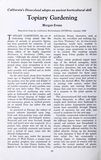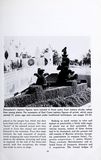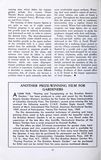


Morgan Evans, Burbank, California, is Landscape Architect for Walt Disney Productions. The 9% million visitors per year at Disneyland find the whimsical topiary figures amusing, but at the same time recognize their horticultural excellence.
Reprinted from the California Horticultural JOURNAL, January 1969
Topiary gardening, the art of fashioning living plants into the shapes of animals or geometric figures, has been practiced for centuries, if not millennia, and has both its advocates and detractors. One of the latter, George Nicholson, editor of the highly respected Dictionary of Gardening (1888), comments, "Although the absurd fashion of cutting and torturing trees into all sorts of fantastic shapes has hopefully almost passed away, some recognition is in order." Mr. Nicholson's sentiments were quite possibly well justified and no doubt were shared by many.
On the other hand, about three hundred years ago in England and Europe, topiary gardens were the pride and delight of royalty and landed gentry, and a number of notable examples of such gardens may still be seen there today. This very specialized form of gardening was never quite as fashionable in this country, and although formal shaping of hedges and columns in the Williamsburg tradition are not uncommon, plants in stylized geometric or animal form are rather few and far between.
As practiced in Europe, the culture of topiary subjects depended upon long-lived and slow-growing trees and shrubs with appropriately fine-foliaged texture. Boxwood and yew were favored, though holly and laurel were also employed. As a general rule, plants were set out at an early age, carefully nurtured, and trained over a period of many years into the desired configuration.
A few years ago, under the personal direction of Walt Disney, a unique topiary garden program was commenced at Disneyland. In true Disney fashion, the figures to be produced were drawn from well-known Disney characters, such as Dumbo, the crocodiles and waltzing hippos from "Fantasia," etc. As true-to-scale reproduction would have resulted in figures too large for the garden they were to occupy, some compromise in size had to be reached. The resulting animals ranged from 2-foot poodles to 10-foot giraffes.
Disney artists produced expert drawings of the desired menagerie, which were then enlarged to actual size of the respective characters, but now came the sticky problem. The debut of this Disney troupe was scheduled for three years hence and normal topiary practices would have required many times that period to achieve the desired effect. The answer lay in starting with mature, rather than young plants, and coercing them into shapes that must have come as something of a surprise to the plant species involved.
The aforementioned full scale drawings became blueprints, in effect, and light-weight steel skeletons were fashioned to match the prints. Appropriate plant materials were assembled, through diligent search of nurseries far and wide, and stored in readiness for the next step.
Carefully constructed redwood boxes of varying sizes and shapes to accommodate the different figures were constructed. A special soil mixture was formulated to ensure adequate drainage and aeration and yet provide sufficient stability for the tallest subjects. Sizing up the drawings (in most instances 4 feet of the animal were called for, but occasionally a waltzing hippo or balancing elephant meant only one point of contact with the earth), the correct number of plants, perhaps two short and two tall ones, were placed in the proper box, which was then back-filled with the soil mixture. The steel "bones" of the selected animal were then joined to form this animal and securely fastened to the container. From this stage forward, the task consisted of progressively wrapping the main branches of each plant to the skeleton, trimming and tying as required. At the end of the three-year period, with few exceptions, the troupe was ready to move on stage.
Seeking as much variety in color and texture as practicable, a fairly wide range of plants was at first assembled. For various reasons, certain of these choices had to be eliminated, and the present roll call consists of Myrsine africana, Syzygiuvi paniculatum (a compact form), Cupressus sempervirens, C. glabra 'Gareei,' Thuja orientalis 'Beverleyensis,' and selected forms of Juniperus chinensis and J. scopulorum. The formal hedges of varying sizes which define the topiary garden include Ilex crenata 'Green Thumb' Buxus japonica, Syzygium panculatum (compact form), Murray a exotica, and Ficus retusa.
The training of these topiary figures is not quite as easy as it might sound. Vertical progress is no great problem, but growth must be induced horizontally and downward as well, in order to achieve the desired form. The three-dimensional shapes invariably create shaded areas, so that healthy growth in the upper surface of the extended limb is a much easier matter than the underside. The constant shearing required to suppress growth is not always enjoyed by the plant, and extreme care must be taken to avoid exposing woody cuts. Plants are subject to normal attack by various insects and diseases, which can cause disproportionate problems where every square inch of surface is important. Continual growth is desirable to sustain the more difficult exposures, but, of course, can become a problem when it quite naturally seeks the more comfortable upper surfaces. Watering, that most sensitive aspect of successful plant culture, can make or break a project. Throughout the three-year period that the plants were held in containers, tensiometers were a regular fixture for every animal. Where four individual trees comprise one large figure, two or more tensiometers were necessary to guide the gardeners charged with their well-being.
Today, visitors to Disneyland, nearly nine-and-one-half million per year, are welcomed to the "It's A Small World" adventure by a waltzing hippo poised on one toe (Thuja orientalis 'Beverleyensis'), flanked by a poodle and a pig (Myrsine africana), and back-dropped by an array of bears, elephants, seals, and giraffes, twenty in number – inanimate, but alive and well. The same gardeners who patiently nurtured the members of this circus troupe through their formative years are now responsible for their care and feeding. Evidence of their earnest effort is to be found in the happy appearance of their charges.